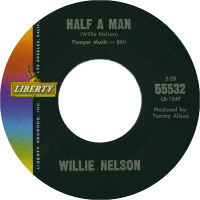Half a Man
| "Half a Man" | ||||
|---|---|---|---|---|
 | ||||
| Single by Willie Nelson | ||||
| B-side | "The Last Letter" | |||
| Released | January 1963 | |||
| Recorded | December 1962 at Bradley's Barn Studio (Nashville, Tennessee) | |||
| Genre | Country | |||
| Length | 2:25 | |||
| Label | Liberty | |||
| Songwriter(s) | Willie Nelson | |||
| Producer(s) | Tommy Allsup | |||
| Willie Nelson singles chronology | ||||
| ||||
"Half a Man" is a song written and recorded by American country music singer Willie Nelson. The song was released as the A-side of the single for his second Liberty Records album, Here's Willie Nelson. Despite receiving mixed airplay for its content, the song became a sales success, peaking at number twenty-five on Billboard's Hot Country Singles and number twenty on Cashbox's country singles.
Writing and recording
Nelson was inspired to write the song after waking up in the middle of the night to smoke a cigarette. With his arm around a sleeping woman, he could not release it without waking her up. Nelson reached for the cigarette with his other arm, and imagined how it would be to only have half of his body.[1] The song told the story of a man who declared that if he lost part of his body, he would resemble the "half a man" that lost love turned him into.[2]
"Half a Man" was recorded during a December 1962 session, produced by Tommy Allsup.[3] Recorded at Bradley's Barn, Nelson was backed by fiddler Tommy Jackson and guitarists Jerry Kennedy, Wayne Moss, and Fred Carter, Jr.[4] The chorus of the song was accentuated by female backing singers.[2] The drummer was Earl Palmer.[5]
Release and Reception
The single, coupled with a cover of Rex Griffin's "The Last Letter" was released to promote his second Liberty Records release, Here's Willie Nelson.[4] On a January 1963 review of the single, Billboard called the song as: "(a) potent country reading of a most unusual tune in which the lad pleads for his lass", while describing that tune contained "(the) most unusual imagery".[6]
Despite that the airplay of the song was affected by stations that considered it "morbid",[4] the release reached by April number twenty-five on Billboard's Hot Country Singles.[7] While it remained on Billboard's chart for five weeks,[8] it spent twelve weeks on Cashbox's country singles chart, and peaked at number twenty.[9]
Other recordings
Merle Haggard covered the song in his 1982 release Going Where the Lonely Go.[10] Nelson recorded again the track in a duet with George Jones for his 1985 duet album Half Nelson.[11]
Chart performance
| Chart (1963) | Peak position |
|---|---|
| Billboard Hot Country Singles | 25[8] |
| Cashbox Country Singles | 20[9] |
Footnotes
- ^ Emery, Ralph 2001, p. 201.
- ^ a b Rolling Stone staff 2010.
- ^ Thomson, Graeme 2012, p. 67.
- ^ a b c Patoski, Joe Nick 2008, p. 140.
- ^ Scherman, Tony, Backbeat: The Earl Palmer Story, forward by Wynton Marsalis, Smithsonian Institution Press, Washington D.C., 1999 p. 176
- ^ Billboard staff 1963, p. 24.
- ^ Scobey, Lola 1982, p. 112.
- ^ a b Whitburn, Joel 2001, p. 244.
- ^ a b Albert, George; Hoffmann, Frank 1984, p. 247.
- ^ Erlewine, Stephen Thomas; Bogdanov, Vladimir; Woodstra Chris 2003, p. 311.
- ^ Billboard staff 1985, p. 65.
References
- Albert, George; Hoffmann, Frank (1984). The Cash box country singles charts, 1958–1982. Scarecrow Press. ISBN 978-0-8108-1685-5.
{{cite book}}: Invalid|ref=harv(help) - Billboard staff (1963). "Singles Review". Billboard. 75 (3). Nielsen Business Media, Inc. ISSN 0006-2510.
{{cite journal}}: Invalid|ref=harv(help) - Billboard staff (1985). "Willie Comes to Grips with 'Half Nelson'". Billboard. 97 (35). Nielsen Business Media, Inc. ISSN 0006-2510.
{{cite journal}}: Invalid|ref=harv(help) - Emery, Ralph (2001). 50 Years Down a Country Road. Harper Collins. ISBN 978-0-06-093703-4.
{{cite book}}: Invalid|ref=harv(help) - Erlewine, Stephen Thomas; Bogdanov, Vladimir; Woodstra Chris (2003). All Music Guide to Country: The Definitive Guide to Country Music. ISBN 978-0-87930-760-8.
{{cite book}}: Invalid|ref=harv(help) - Patoski, Joe Nick (2008). Willie Nelson: An Epic Life. Hachette Digital. ISBN 978-0-316-01778-7.
{{cite book}}: Invalid|ref=harv(help) - Rolling Stone staff (2010). "Song Stories". Retrieved July 29, 2014.
{{cite web}}: Invalid|ref=harv(help) - Thomson, Graeme (2012). Willie Nelson: The Outlaw. Virgin Books. ISBN 978-0-7535-1184-8.
{{cite book}}: Invalid|ref=harv(help) - Scobey, Lola (1982). Willie Nelson: Country Outlaw. Kensington Pub Corp. ISBN 978-0-89083-936-2.
{{cite book}}: Invalid|ref=harv(help) - Whitburn, Joel (2001). Joel Whitburn's Top Pop Albums, 1955–2001. Record Research. ISBN 978-0-89820-147-5.
{{cite book}}: Invalid|ref=harv(help)
